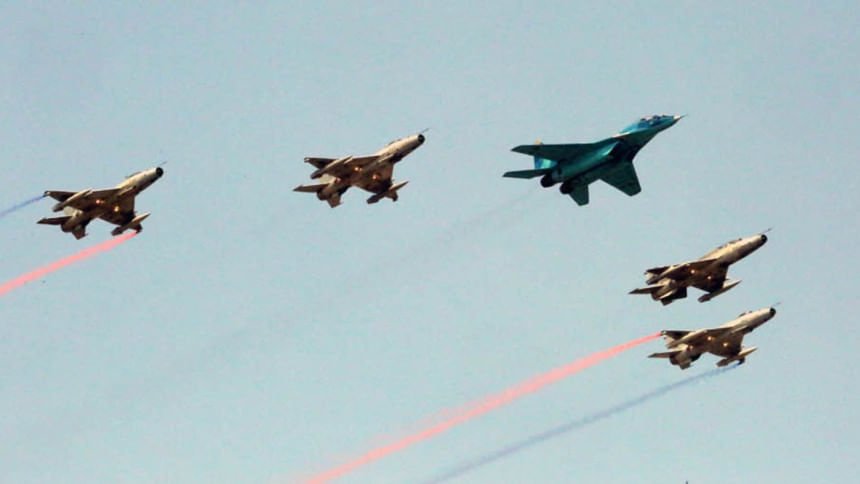The recent collision involving a Bangladesh Air Force fighter jet and Milestone School on July 21, 2025, served as a critical national moment highlighting deep-rooted planning negligence. It was not just an unfortunate incident but a stark reflection of long-standing issues. The tragic toll of the event has left a lasting impact on the nation’s collective memory.
Beyond a mere mechanical failure, the crash exposed a significant strategic void—an evident disparity between the country’s development trajectory and the evolution of its air defense capabilities. Amidst economic aspirations, urban growth, and regional uncertainties, Bangladesh’s military infrastructure has lagged behind. The pressing need extends beyond equipment upgrades, emphasizing a fundamental review of the strategies underpinning airspace protection.
The concept of airspace security has evolved from a static boundary to a dynamic domain, necessitating comprehensive surveillance, swift responses, and unified command structures. Bangladesh faces a critical imperative in safeguarding its airspace due to its proximity to India, a formidable regional air power, and Myanmar, a nation experiencing escalating militarization and instability along its borders.
The nation’s airspace is characterized by congestion and vulnerabilities arising from civil aviation, military activities, and the surge in unregulated drone operations. These factors pose threats to vital installations and populated areas. Presently, Bangladesh operates on a fragmented system where reactive measures substitute proactive planning, leaving crucial gaps in coverage that rely more on hope than actual capability.
To address these challenges, Bangladesh must establish a robust national airspace framework built on three pillars: continuous early warning systems, a nimble interceptor fleet, and data fusion centers enabling seamless coordination between military and civilian sectors.
Recognizing the strategic significance of air power, which transcends battlefield applications to encompass diplomatic, deterrence, and doctrinal realms, is vital. Nations utilize air power not only for defense but also to define their roles within global geopolitical structures and economic orders.
The evolving landscape in South Asia exemplifies this trend. India’s strategic expansion of air bases signifies more than defense preparations, serving as a strategic communication tool. Myanmar’s military regime, despite international pressures, invests heavily in combat aircraft to assert internal control and regional influence.
Bangladesh must not remain static while its neighbors progress. Air power signifies more than just proximity; it symbolizes presence and the ability to dominate the skies, aligning with national aspirations. Whether responding to cross-border threats, engaging in humanitarian missions, or projecting geopolitical deterrence, mastering airspace control is integral to Bangladesh’s advancement and prosperity.
Singapore offers a valuable model with its credible air power doctrine based on pre-emptive strategies, networked platforms, and technological supremacy instead of sheer numbers. Bangladesh’s Forces Goal 2030 envisioned a shift towards a modernized tri-service structure emphasizing strategic deterrence and interoperability. However, the pace of implementation remains sluggish, particularly within the Air Force.
Lack of role clarity within the Air Force leads to reactive measures, fragmented procurement strategies, and undermines diplomatic efforts. As regional air doctrines evolve towards integrated multi-domain operations, Bangladesh must adapt swiftly to avoid being left behind by outdated assumptions.
Dispelling the notion that Bangladesh cannot afford air modernization is crucial. National security is a public good essential for economic and social stability. A modern air force not only deters conflicts but also supports disaster response, border surveillance, counterterrorism, and civil-military coordination. It acts as both a shield and a catalyst for development.
While military expenditure in Bangladesh remains relatively low at one percent of GDP, falling behind regional counterparts, smart allocation prioritizing strategic capabilities can bridge the gap. Modernization efforts should focus on integrating capabilities like Airborne Warning and Control System (AWACS), multirole combat aircraft (MRCA), anti-drone systems, and electromagnetic warfare readiness into a cohesive force.
The challenges of urban density in Dhaka disrupting safe air operations underscore the need for timely air base relocations and enhanced coordination between military and civil aviation. Overcoming political and institutional obstacles to strategic prioritization is crucial for ensuring effective defense planning encompassing all operational domains.
Securing airspace sovereignty demands a clear doctrine, robust deterrence capabilities, and a commitment to modernization. A proficient air force not only defends national skies but also provides the agility, reach, and resilience essential in an era of rapid threats. It acts as a key enabler of national progress, safeguarding economic development from security vulnerabilities.
The tragic incident of July 21 serves as a pivotal moment prompting Bangladesh to rethink its defense strategies, regain control of its airspace, and modernize with a clear purpose—not merely to ascend higher but to envision a safer, more secure future.

